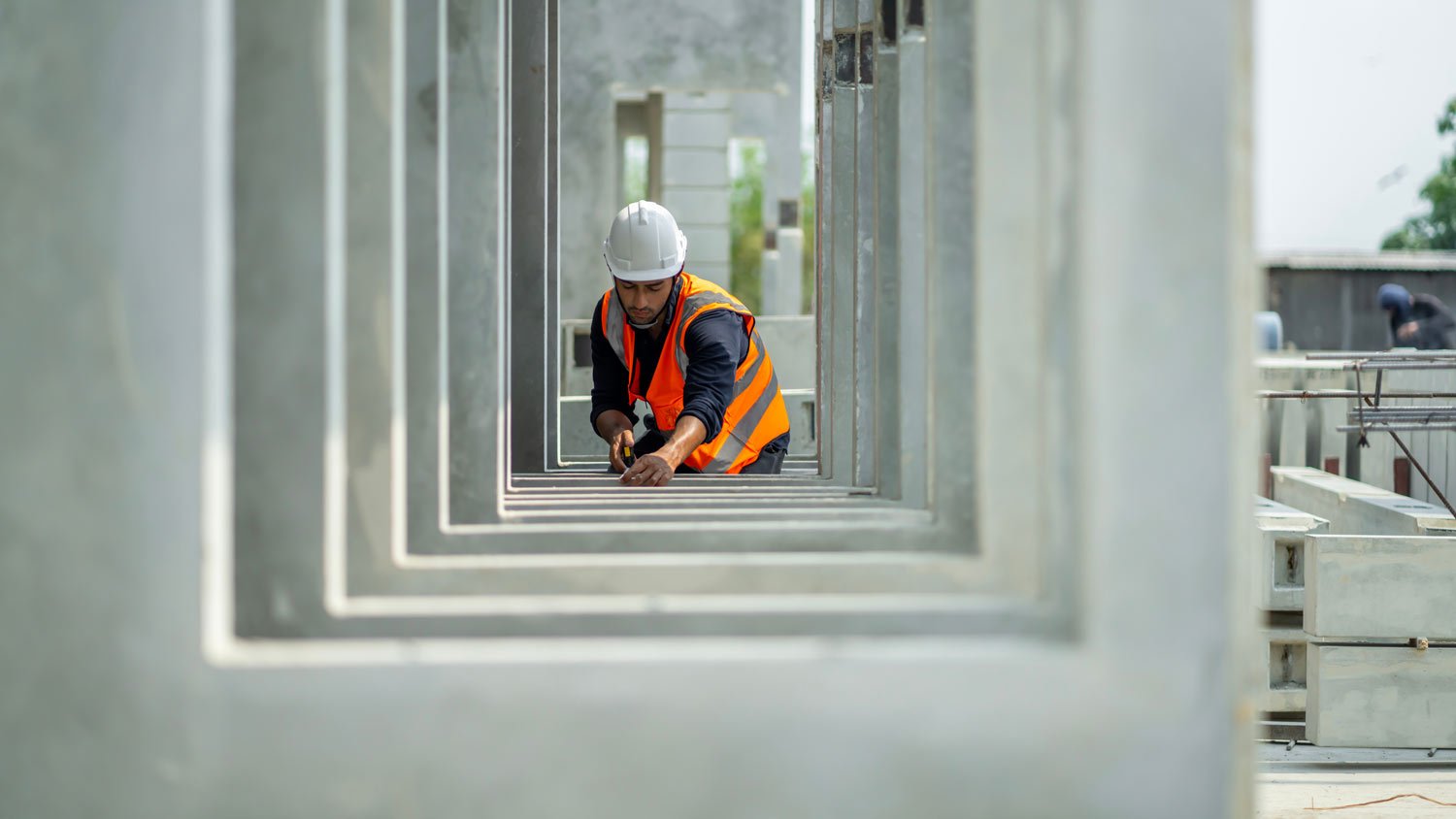
Between the endless customizations and decades of strength, the cost of a concrete driveway may be worth the investment. Let's break down your bottom line.
Precast concrete offers a time-saving alternative to concrete poured on-site


Precast concrete is poured off-site using standardized molds and transported to the job site.
Walls, slabs, beams, stairs, and more can be constructed using precast concrete.
This material offers consistency, fast installation, and cost savings compared to concrete poured on-site.
If you’re building or renovating a home, it’s likely you’ve heard the term “precast concrete” since this construction material has become a common component used in building homes. If you’re not sure what precast concrete is or if it’s right for your project, this guide explores what makes precast concrete different, how it’s used, and its benefits and drawbacks.
Precast concrete is a construction material consisting of concrete poured into a mold, cured in a controlled environment, and transported to a construction site ready to use. Unlike traditional cast-in-place concrete, which is poured into forms or molds and cured on-site, precast concrete arrives at the job site already formed and ready to be lifted into place. This type of concrete is a popular choice for construction projects due to its consistency, convenience, and time savings.

Precast concrete is used in various ways for building homes. Precast concrete slabs are a popular alternative to pouring a slab on-site. A precast concrete slab may cost more in material costs than concrete poured on-site, but the savings in labor costs can make it cost-effective for many projects.
This versatile material is also used for walls, beams, foundations, concrete floors—even concrete steps. Precast concrete can also be used to make retaining walls and septic tanks, so a wide range of projects may offer the option for precast concrete components.
Precast concrete is a great choice for many projects, but there are some factors to consider when deciding between precast and cast-in-place concrete.
| Pros | Cons |
|---|---|
| Consistent shape and quality | Harder to transport |
| Saves on-site curing time | May require specialized installation equipment |
| Controlled curing environment | Higher material costs |
Precast concrete is a popular choice for several reasons. Precast concrete offers consistently sized components because it’s poured into prefabricated molds rather than forms built on-site. Its consistency in curing is also an advantage—because it’s cured in a controlled environment rather than outside at a job site, temperature and moisture variations won’t affect the concrete.
One of the biggest reasons to choose precast concrete is the time savings. Cast-in-place concrete can take days or weeks to cure, adding time to your construction schedule. Precast concrete arrives at the job site fully cured and ready to install, so you won’t waste time waiting for it to be ready for the next stage of construction.
While the fact that precast concrete is ready to use as soon as it’s delivered is a big selling point, transportation and installation can be a drawback. Transportation costs can be prohibitive depending on how far the construction site is from where the concrete is manufactured.
These large concrete pieces have to make their way to the job site fully formed, so they require specialized—and often expensive—equipment to install them. Cranes are often used to lift precast concrete into place, which can add to the project cost.
Precast concrete can also cost more than cast-in-place concrete due to material and transportation costs. In many cases, though, the time savings from using precast concrete can result in a lower overall project cost, so consider all the cost factors when deciding which type of concrete to use.
"The easiest way to avoid concrete burns is to wear long sleeves, gloves, and a mask when working with concrete. If the concrete does come into contact with your skin, simply use a hose or cold water to get it off as soon as possible."
— Mitch Coluzzi, Head of Construction at SoldFast
Precast concrete is a durable, long-lasting material that can stay in great condition for decades with some routine maintenance. Ensuring that your precast concrete is properly sealed goes a long way to extending its lifespan and makes it easier to prevent staining. Perform regular cleaning according to the manufacturer’s instructions and re-seal as needed to prevent discoloration and deterioration. In addition, inspect your precast concrete annually to identify any minor repairs that are needed.

While precast concrete components mean you don’t need experience with pouring concrete unless you have the equipment and expertise necessary to install it, your best bet is to hire a local concrete wall pro. Professional concrete contractors will ensure all components are installed correctly and that the project is safe and up to code.
Depending on where you live, local building codes may require a licensed contractor for specific building projects, so check your municipality’s regulations before attempting DIY concrete projects.
From average costs to expert advice, get all the answers you need to get your job done.

Between the endless customizations and decades of strength, the cost of a concrete driveway may be worth the investment. Let's break down your bottom line.
Need to breathe new life into your exterior stoop? Use this guide on concrete step repair cost to see the price of a professional repair.

Concrete driveways stand up to a lot of pressure over the years. How much do concrete driveway repairs cost when it's time to give it a little TLC?

Are you planning to pour a new concrete driveway? Keep tire track imprints off your new driveway by knowing how long before you can drive on concrete.

Exposed aggregate concrete allows you to customize the look and finish of concrete fixtures. Learn more about this versatile finish and its pros and cons.

Sinking concrete can lead to major property damage if you don’t solve the underlying issue. Learn what causes concrete to sink and how to fix the problem.